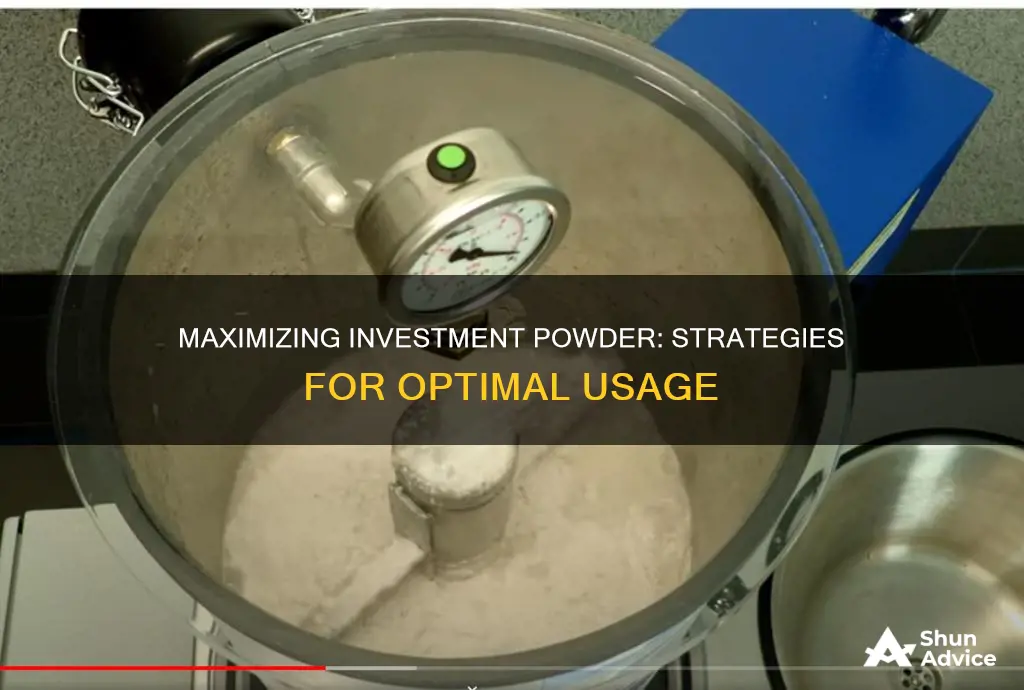
Investment powder is a crucial component in the manufacturing of jewellery and improper handling can lead to losses in production and money. It is important to follow the correct procedure when using investment powder, including proper storage, good water quality, correct mixing ratios, sufficient mixing methods, and controlled temperatures. The investment powder should always be added to water, and the specific water-to-powder ratio provided by the manufacturer should be followed. Additionally, the water temperature should be between 70°F and 75°F, as colder water extends work time, while warmer water shortens it. After mixing, the flasks should be left undisturbed for two hours. The burnout cycle can then be followed, ensuring the removal of carbon residue to prevent gas porosity in the casting alloys.
| Characteristics | Values |
|---|---|
| Water/Powder Ratio | 40/100 or 38/100 (ounces/millilitres) |
| Water Temperature | 70° F- 75° F |
| Investment Temperature | Should be stored at a consistent temperature |
| Working Time | Elapsed time between adding powder to water and when the investment thickens |
| Pour Time | Time it takes the investment to become too thick to pour |
| Set Time | Time it takes the investment to become too hard for a Vicat needle to penetrate more than 1mm |
| Fluidity | Measured using a slump test |
| Casting Temperatures | Ladies' rings: 900° F-1000° F; Gents' rings: 700° F-900° F |
| Burnout Cycle | 5, 8 or 12 hours |
| Curing Time | Minimum of 1 hour for small flasks, 2 hours for larger flasks |
| Low-Temperature Cycle | 250-300° F for 1.5-3 hours |
| High-Temperature Cycle | Maximum of 1350° F for 3-5 hours |
| Ramp-Up and Ramp-Down Speed | Average speed of 4° F/minute to avoid steam and thermal shock |
What You'll Learn

Always add powder to water
When using investment powder, it is important to always add the powder to the water. This is because the working time is dependent on when the powder is added to the water. The working time is the time that elapses between adding the powder to the water and when the investment thickens. This is different from the pour time, which is the time it takes the investment to become so thick that it won't pour.
Adding the powder to the water ensures that you are controlling the process variables and helps to prevent improper handling of the investment powder, which can reduce casting quality. It is also important to use the correct water-to-powder ratio, as this affects many investment properties. The ratio will depend on the specific investment powder being used, but a common ratio is 38 or 40 grams of powder to 100 ml of water.
It is also important to control the temperature of the water, as this can affect the working time. Colder water extends the work time, while warmer water shortens it. The water temperature should be between 70°F and 75°F and should be measured with a thermometer to ensure consistency. The investment powder should always be stored at the same temperature, and the water temperature should be adjusted to compensate for any changes in the temperature of the powder.
Additionally, it is crucial to properly store the investment powder. It is hydroscopic and can absorb moisture from humidity, a damp concrete floor, or rapid changes in temperature. It should be stored in a dry environment, and after use, excess air should be expelled from the plastic bag and the lid should be closed tightly.
Best Places to Invest Your Cash Today
You may want to see also

Mix for 3-5 minutes
When using investment powder, it's important to follow the correct mixing procedure to ensure optimal results and avoid defects in your castings. Improper handling of investment powder can lead to reduced casting quality and loss of production and money. Here's a step-by-step guide for mixing investment powder, focusing on the "Mix for 3-5 minutes" step:
Step 1: Prepare the Water and Powder
Before you begin, ensure you have the correct water-to-powder ratio specified by the manufacturer. Typically, jewellery investments require a ratio of 38 or 40 grams of powder to 100 ml of water. Always use a graduated cylinder for accurate measurements. Prepare the water by checking its temperature, which should be between 70°F–75°F (21°C–24°C). Colder water extends the work time, while warmer water shortens it.
Step 2: Combine the Water and Powder
Now, it's time to combine the water and powder. Always add the investment powder to the water, never the other way around. Pour the specified amount of water into your mixing container, and then slowly add the investment powder. Take your time to avoid creating excess dust.
Step 3: Mix Thoroughly
Once you have added all the powder to the water, start mixing the two components together. Use a mechanical mixer or a whisk to mix the investment powder and water for 3 to 5 minutes. Ensure that you mix thoroughly and scrape the sides of the container occasionally to incorporate all the powder into the mixture. The mixing time can vary depending on the specific product and your desired consistency, so refer to the manufacturer's instructions.
Step 4: Vacuum the Mixing Bowl
After mixing, it's time to remove any air bubbles from the mixture. Use a vacuum pump or similar equipment to vacuum the mixing bowl for about 20 seconds. This step helps ensure that your final castings are free of air pockets and other defects.
Step 5: Check Consistency
At this point, you should observe the consistency of your investment mixture. It should have a creamy, lump-free texture. If you notice any lumps or clumps, mix for an additional minute or until they are completely dissolved. A proper mix is crucial to achieving successful castings.
Step 6: Pour into Flask
Once you have a smooth and homogeneous mixture, carefully pour it into your flask or mould. Fill the flask to the desired level, usually leaving some space at the top. Ensure that your flask is placed on a stable surface free from vibration or movement.
Tips for Optimal Results:
- Always use a timer when mixing to ensure accuracy and consistency.
- Store your investment powder properly in a dry environment to prevent moisture absorption and chemical changes.
- If you notice any changes in colour or texture, discard the powder and use a fresh batch.
- For larger batches or more complex jewellery designs, you may need to adjust your mixing time accordingly.
- Always follow the manufacturer's instructions and safety guidelines when working with investment powder.
By following these detailed steps and paying close attention to the "Mix for 3-5 minutes" instruction, you can ensure that your investment powder is properly mixed and ready for the next steps in the casting process.
A Beginner's Guide to Investing via Binance
You may want to see also

Vacuum the mixing bowl
To vacuum mix a powder, you will need a vacuum mixer or a similar device with a vacuum pump and mixing capability. This process is often used in dental laboratories and the medical industry, as well as in casting and moulding applications. Here is a step-by-step guide:
Firstly, ensure your vacuum mixer is set up correctly and all components are securely attached. This includes the vacuum pump, which should be connected to the mixer, and the mixing bowl, which should be firmly attached to the mixer. Check that the vacuum hose is securely connected to the pump and the mixer, ensuring an airtight seal for efficient vacuuming.
Next, place the investment powder into the mixing bowl. The amount of powder will depend on the size of your mould or casting, so refer to specific instructions or recipes for the correct proportions. It is important to wear personal protective equipment, including gloves, eye protection, and a respirator, as investment powders can be hazardous if inhaled or if they come into contact with skin or eyes.
With the powder in the mixing bowl, initiate the vacuum pump to begin removing air from the mixing bowl and the powder. The time required for this step will depend on the size and power of your pump, as well as the volume of powder. Ensure the vacuum is maintained throughout the mixing process to avoid air bubbles or pockets of air, which could compromise the quality of the final product.
As the vacuum pump operates, start the mixer to agitate and thoroughly mix the investment powder. Mix for several minutes, or as specified by instructions, keeping the mixer running during the vacuuming process for consistent results. Once mixing is complete, you can stop the mixer but maintain the vacuum for a little longer to ensure all air is removed from the mixed investment powder.
Finally, release the vacuum and carefully remove the mixed investment powder from the mixing bowl. It is now ready to be used according to your specific application, be it creating a mould, casting, or another process. Remember to clean your equipment after each use to maintain the integrity of your work and the longevity of your tools.
Strategies for Investing Uninvested Cash in a VA529 Plan
You may want to see also

Pour into flask
Once the investment powder and water have been thoroughly mixed, it's time to pour the mixture into a flask. This process should be done with care to avoid any spills or mess. Here are some detailed instructions for this step:
Before pouring, ensure you have the correct flask size for your specific application. The flask should be clean and dry, free from any residue or contaminants. It is important to work quickly but carefully as the mixture will start to thicken and the working time is limited.
When you are ready, carefully pour the investment mixture into the flask. Fill it to the desired level, typically just below the top to allow for a small amount of expansion. Ensure the flask is on a level surface to achieve an even fill. Take your time and pour steadily to avoid air bubbles or an uneven surface forming in the flask.
Once the flask is filled, place it on a countertop or table that is stable and free from vibration or movement. This will ensure the mixture sets evenly without any disturbances. Allow the flask to sit undisturbed for the recommended time, typically around two hours, to give the investment time to harden and reach its full green strength.
During the hardening process, you may notice the appearance of the mixture change. Within a few minutes, the glossy wet surface will transform into a frosty, matte finish. This is a normal part of the process and indicates the mixture is curing.
After the allotted time has passed, the flask is ready for the next step in the process, which is the burnout cycle. This involves placing the flask in a furnace or oven and gradually increasing the temperature to remove any remaining water and pattern material, as well as to strengthen the investment mould.
By following these steps for the "Pour into flask" stage, you will ensure the investment mixture is properly contained and prepared for the subsequent steps in the process of using investment powder.
Perforated Investment Flask: Easy Steps for Usage
You may want to see also

Gloss off
Gloss-off is an important stage in the process of using investment powder to create jewellery moulds. It refers to the moment when the glossy, wet appearance of the invested flask turns into a frosty, matt look with no reflectivity. This should happen about 10 minutes after the powder is added to the water.
The time it takes for gloss-off to occur is an important indicator of whether the correct mixing steps are in place. If gloss-off happens in less than a minute, you should reduce your mixing time. If it takes longer than two minutes, you should increase your mixing time. If gloss-off takes too long, the water and solids may start to separate, resulting in watermarks on your castings. Therefore, it is important to monitor the gloss-off time and adjust your mixing process accordingly.
The time taken for gloss-off can also be affected by the number of flasks being invested. If you are investing more flasks, your total work time will be longer, so you should adjust your mix time accordingly.
It is worth noting that improper handling of investment powder can lead to a loss of production and money. This includes improper storage, poor water quality, wrong mixing ratios, insufficient mixing methods, and uncontrolled temperatures. Therefore, it is important to follow the user instructions and technical support provided by investment powder manufacturers to ensure a successful casting process.
Investing Cash During Inflation: Strategies for Success
You may want to see also
Frequently asked questions
The ratio is typically 38-40 grams of powder to 100ml of water.
Mix the powder and water for 3-5 minutes, then vacuum the mixing bowl. Pour the mixture into flasks, and vacuum each flask.
The top of the flask will initially look glossy and wet. After 1-2 minutes, this will change to a frosty, matt appearance. This is called "gloss-off".
The furnace should be preheated to 300° F / 149°C.







